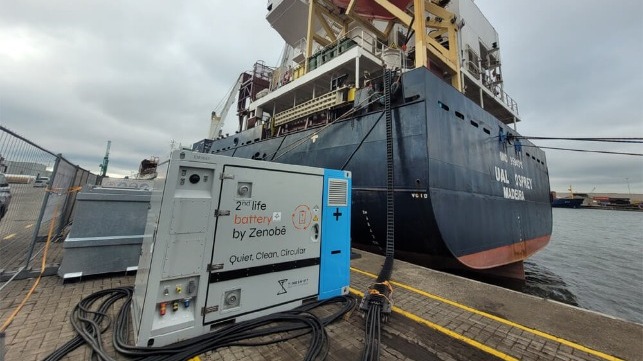Unique Solution Explores Batteries to Provide Ships with Shore Power

One of the challenges to meeting the requirements for converting shipping to cold ironing in ports is the lack of infrastructure and capacity on the local power grid to support vessels. Ports are also facing a large financial challenge to provide the capabilities.
A new pilot project which was launched last week at one of the terminals in the Port of Antwerp looks to solve the challenge and especially make shore power available to smaller ports through the use of a battery solution. The first phase of the test was launched at logistics company Zuidnatie’s terminal in which shore power was connected to the ocean-going vessel. It also uses a unique batter solution from Zenobe, a start-up launched to build energy networks using batteries.
Participating in the test was the UAL Osprey, an 8,500 dwt general cargo ship operated by the shipping company UAL. The vessel is 11 years old and is outfitted to use shore power when it is available in port.
Shore power however at the Port of Antwerp however is currently limited in its availability. The Port Authority has installed it for its own vessel and has it widely available for inland craft. The port is committed to expanding the use of shore power focusing on the largest containerships but they do not project have the capability available before 2028.
The aim of the pilot project that is now underway is to collect measured data on consumption and consumption peaks, something that has not yet been researched. Zenobe chose a 150 kWh Powerskid, backed up by two generators, to capture and record the peaks.
In the pilot project, Zenobe is also using a second-life battery, also known as a Powerskid. It is a battery used in a previous life to power electric buses. In this way, Zenobe is ensuring that the battery gets a second life ensuring the battery minerals are used for as long as possible.
In a second phase, the battery will be scaled up and the additional generators will no longer be needed. The battery will then be powered by Zuidnatie’s PV plant. The delivered voltage will be 400 volts and the energy will be brought on board by means of a cable package.
In the long term, Zuidnatie wants to offer this form of shore power to all shipping companies calling at the terminals. At a later stage, Zuidnatie plans to use the generated energy from its solar panels as a power source to charge the batteries.
